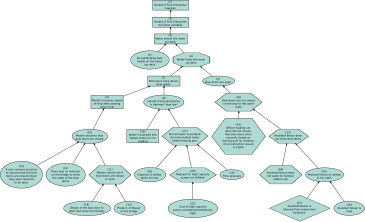Causality (also called causation, or cause and effect) is an influence by which one event, process, state, or object (acause) contributes to the production of another event, process, state, or object (an effect) where the cause is partly responsible for the effect, and the effect is partly dependent on the cause. In general, a process has many causes, which are also said to be causal factors for it, and all lie in its past. An effect can in turn be a cause of, or causal factor for, many other effects, which all lie in its future. Some writers have held that causality is metaphysically prior to notions of time and space.
The phrase "correlation does not imply causation" refers to the inability to legitimately deduce a cause-and-effect relationship between two events or variables solely on the basis of an observed association or correlation between them. The idea that "correlation implies causation" is an example of a questionable-cause logical fallacy, in which two events occurring together are taken to have established a cause-and-effect relationship. This fallacy is also known by the Latin phrase cum hoc ergo propter hoc. This differs from the fallacy known as post hoc ergo propter hoc, in which an event following another is seen as a necessary consequence of the former event, and from conflation, the errant merging of two events, ideas, databases, etc., into one.

Teleology or finality is a branch of causality giving the reason or an explanation for something as a function of its end, its purpose, or its goal, as opposed to as a function of its cause.
Physical causality is a physical relationship between causes and effects. It is considered to be fundamental to all natural sciences and behavioural sciences, especially physics. Causality is also a topic studied from the perspectives of philosophy, statistics and logic. Causality means that an effect can not occur from a cause that is not in the back (past) light cone of that event. Similarly, a cause can not have an effect outside its front (future) light cone.
In philosophy, an action is an event that an agent performs for a purpose, that is guided by the person's intention. The first question in the philosophy of action is to determine how actions differ from other forms of behavior, like involuntary reflexes. According to Ludwig Wittgenstein, it involves discovering "[w]hat is left over if I subtract the fact that my arm goes up from the fact that I raise my arm". There is broad agreement that the answer to this question has to do with the agent's intentions. So driving a car is an action since the agent intends to do so, but sneezing is a mere behavior since it happens independent of the agent's intention. The dominant theory of the relation between the intention and the behavior is causalism: driving the car is an action because it is caused by the agent's intention to do so. On this view, actions are distinguished from other events by their causal history. Causalist theories include Donald Davidson's account, which defines actions as bodily movements caused by intentions in the right way, and volitionalist theories, according to which volitions form a core aspect of actions. Non-causalist theories, on the other hand, often see intentions not as the action's cause but as a constituent of it.
Indeterminism is the idea that events are not caused, or are not caused deterministically.

Libertarianism is one of the main philosophical positions related to the problems of free will and determinism which are part of the larger domain of metaphysics. In particular, libertarianism is an incompatibilist position which argues that free will is logically incompatible with a deterministic universe. Libertarianism states that since agents have free will, determinism must be false and vice versa.
The deductive-nomological model of scientific explanation, also known as Hempel's model, the Hempel–Oppenheim model, the Popper–Hempel model, or the covering law model, is a formal view of scientifically answering questions asking, "Why...?". The DN model poses scientific explanation as a deductive structure, one where truth of its premises entails truth of its conclusion, hinged on accurate prediction or postdiction of the phenomenon to be explained.
Wesley Charles Salmon was an American philosopher of science renowned for his work on the nature of scientific explanation. He also worked on confirmation theory, trying to explicate how probability theory via inductive logic might help confirm and choose hypotheses. Yet most prominently, Salmon was a realist about causality in scientific explanation, although his realist explanation of causality drew ample criticism. Still, his books on scientific explanation itself were landmarks of the 20th century's philosophy of science, and solidified recognition of causality's important roles in scientific explanation, whereas causality itself has evaded satisfactory elucidation by anyone.
Physical causal closure is a metaphysical theory about the nature of causation in the physical realm with significant ramifications in the study of metaphysics and the mind. In a strongly stated version, physical causal closure says that "all physical states have pure physical causes" — Jaegwon Kim, or that "physical effects have only physical causes" — Agustin Vincente, p. 150.

The four causes or four explanations are, in Aristotelian thought, four fundamental types of answer to the question "why?" in analysis of change or movement in nature: the material, the formal, the efficient, and the final. Aristotle wrote that "we do not have knowledge of a thing until we have grasped its why, that is to say, its cause." While there are cases in which classifying a "cause" is difficult, or in which "causes" might merge, Aristotle held that his four "causes" provided an analytical scheme of general applicability.
In the science of biology, a mechanism is a system of causally interacting parts and processes that produce one or more effects. Scientists explain phenomena by describing mechanisms that could produce the phenomena. For example, natural selection is a mechanism of biological evolution; other mechanisms of evolution include genetic drift, mutation, and gene flow. In ecology, mechanisms such as predation and host-parasite interactions produce change in ecological systems. In practice, no description of a mechanism is ever complete because not all details of the parts and processes of a mechanism are fully known. For example, natural selection is a mechanism of evolution that includes countless, inter-individual interactions with other individuals, components, and processes of the environment in which natural selection operates.
Probabilistic causation is a concept in a group of philosophical theories that aim to characterize the relationship between cause and effect using the tools of probability theory. The central idea behind these theories is that causes raise the probabilities of their effects, all else being equal.
Causal reasoning is the process of identifying causality: the relationship between a cause and its effect. The study of causality extends from ancient philosophy to contemporary neuropsychology; assumptions about the nature of causality may be shown to be functions of a previous event preceding a later one. The first known protoscientific study of cause and effect occurred in Aristotle's Physics. Causal inference is an example of causal reasoning.

Causation refers to the existence of "cause and effect" relationships between multiple variables. Causation presumes that variables, which act in a predictable manner, can produce change in related variables and that this relationship can be deduced through direct and repeated observation. Theories of causation underpin social research as it aims to deduce causal relationships between structural phenomena and individuals and explain these relationships through the application and development of theory. Due to divergence amongst theoretical and methodological approaches, different theories, namely functionalism, all maintain varying conceptions on the nature of causality and causal relationships. Similarly, a multiplicity of causes have led to the distinction between necessary and sufficient causes.
Causal analysis is the field of experimental design and statistics pertaining to establishing cause and effect. Typically it involves establishing four elements: correlation, sequence in time, a plausible physical or information-theoretical mechanism for an observed effect to follow from a possible cause, and eliminating the possibility of common and alternative ("special") causes. Such analysis usually involves one or more artificial or natural experiments.
The Bradford Hill criteria, otherwise known as Hill's criteria for causation, are a group of nine principles that can be useful in establishing epidemiologic evidence of a causal relationship between a presumed cause and an observed effect and have been widely used in public health research. They were established in 1965 by the English epidemiologist Sir Austin Bradford Hill.
Causal inference is the process of determining the independent, actual effect of a particular phenomenon that is a component of a larger system. The main difference between causal inference and inference of association is that causal inference analyzes the response of an effect variable when a cause of the effect variable is changed. The study of why things occur is called etiology, and can be described using the language of scientific causal notation. Causal inference is said to provide the evidence of causality theorized by causal reasoning.
In biology, reciprocal causation arises when developing organisms are both products of evolution as well as causes of evolution. Formally, reciprocal causation exists when process A is a cause of process B and, subsequently, process B is a cause of process A, with this feedback potentially repeated. Some researchers, particularly advocates of the extended evolutionary synthesis, promote the view that causation in biological systems is inherently reciprocal.
Universal causation is the proposition that everything in the universe has a cause and is thus an effect of that cause. This means that if a given event occurs, then this is the result of a previous, related event. If an object is in a certain state, then it is in that state as a result of another object interacting with it previously.




